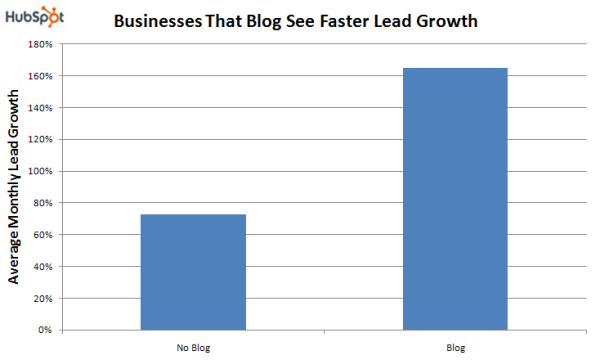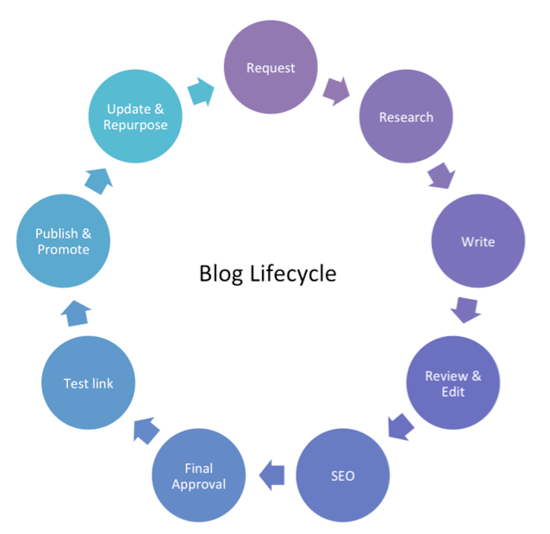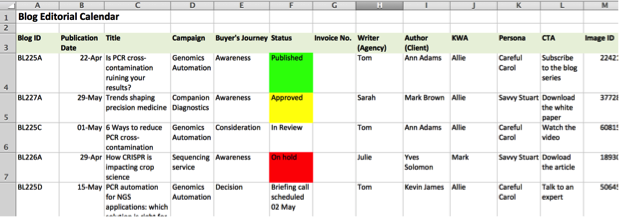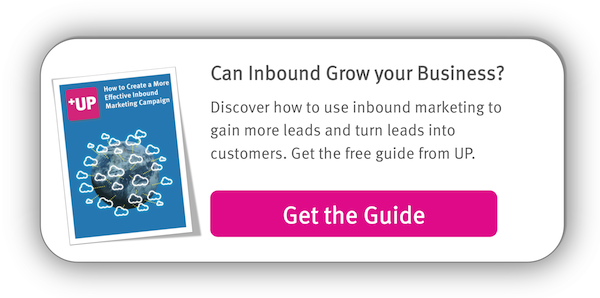You’d be hard-pressed in this age of social media to find a life science business that did not include a blog as part of its inbound marketing strategy, but what does it take to create a successful one? Here are 10 insider tips to get your life science business blog off to a flying start.
First, why should you blog?
There’s no denying the growing influence of social media in the life science industry. Internet connectivity has tipped the scales from a seller’s world to a buyer’s market. Gone are the days when you had to beat a path to your customer’s door. Now they come looking for you in the cloud. And the company with the best inbound marketing strategy often wins their business.
A 2016 PLOS survey exploring the use of social media in the scientific workplace countered the common myth that scientists don’t engage with blogs or other forms of social media:
“When queried specifically about their use of blogs as a form of social media, the majority of scientists (92%) indicated that they read science blogs, and many reported they have shared blog posts with professional colleagues (84%).”
Want to talk to someone about setting up a blog? Free Consult.

As more and more life science businesses confront the challenge of engaging scientists in the digital age, they are seeing the benefits of effective blogging as part of a holistic marketing approach. Here are a few statistics to prove the point:
- Content marketing gets three times more leads than paid search advertising. (Source: Content Marketing Institute, 2017)
- Only 20% of people want to talk to a salesperson to learn more about a product (Source: Hubspot)
- 90% of searchers haven’t decided on abrand before starting their search (Source: Hubspot)
- 80% of business decision-makers prefer to get company information from a series of articles rather than an advertisement. (Source: B2B PR Sense Blog)
- 55% of marketers say blog content creation is their top inbound marketing priority. (Source: HubSpot)
- Marketers who prioritize blogging efforts are 13x more likely to see positive ROI (Source: HubSpot)
- The average word count of top ranked content in Google is between 1,140-1285 words (Source: SearchMetrics)
As these statistics demonstrate, a blog can be a highly cost-effective tool to increase brand awareness, attract new customers, build trust, and create evangelists who will recommend you to their friends and colleagues.
I am being careful to say “can be” effective because the difference between an effective blog and a complete drain on your resources rests heavily on the implementation. As an inbound content manager, I’ve experienced first-hand how important it is to get the blog process and execution right from the outset.
So here goes, here are my:
10 essential tips for creating a successful life science business blog
1. Find your niche.
The number one question to ask before creating any blog is “WHY?”
Life science professionals are discriminating. They are searching for high-quality information, and they can’t afford to waste time reading fluff. Like everyone else, they want quick solutions to their problems. With hundreds of life science blogs competing for their attention, why should they read yours
If your blog site doesn’t have a clearly differentiated focus or address a significant niche area, it’s unlikely to turn up in relevant searches and attract your desired target audience. And if the right people are not going to find or read your blog, why go to all the trouble of creating it in the first place?
A good way to start is to audit what’s already out there. For example, Feedspot keeps an updated list of the top 100 science blogs. Take stock of the ones that seem most relevant to your target audiences, and then look for information gaps that match your organization’s expertise, products and services. Congratulations, you found your niche!
2. Be generous!
It’s a common and costly mistake to think that blogging is all about promoting and selling your products. The truth is that the power of blogging lies in its ability to help you establish credibility, share expertise, engage potential customers, and build their trust. And to do that, you need to give a little something in return.
That’s why it’s no accident that:
90% of B2B content marketers put their audience’s information needs first—ahead of their sales and promotional messaging. Source: CMI 2018 B2B Content Marketing Research
This is as true for the life sciences as for any other market.
When I was in the lab running lots of image-based cell assays, my in-box was flooded with promotional emails from the leading microscope manufacturer. Most of the time, I sent these aggressive emails straight to the trash bin, unopened.
My favorite “go-to” resource was a competitor who never contacted me directly, but regularly dished up reliable information for free: links to the latest scientific articles in my field, in-depth white papers, how-to guides and tips for fluorescence microscopy. Whenever I was developing a new assay, I would turn to their easy-to-use spectral viewer to see the excitation and emission spectra of all my favorite fluorescent dyes, and find out which filters were compatible.
When the time came to purchase an expensive new confocal microscope, which company do you think won my business? You guessed it: not the one bombarding me with ads and product specs, but the one I already knew and trusted because of their useful—and free—resources.
3. Know your audience.
How well do you really know your target customers? If you want to capture their attention and sway their thinking, you need to know them almost as well as you know your best friend.
When writing for the life science market, chances are you’ll be addressing many different types of readers, at different stages in the “buyer’s journey,” with varying degrees of technical expertise, and with different job functions, challenges and interests. Creating a detailed profile, or “persona” for each of your archetypal customer types will help you create more compelling content that speaks persuasively to their needs and desires.
If you’re new to personas and the buyer’s journey, follow this link to find out more about the ABCs of inbound marketing.
4. Invest in great science writers.
Writing is the meat and bones of your blog, so it makes sense to invest in writers who really understand your industry and customer base. They may cost a little more, but believe me it’s worth it.
While your writers do need to be knowledgeable, don’t be fooled into thinking a PhD scientist is necessarily a good science writer. Great life science bloggers are a rare breed. They need to be as passionate, nerdy and knowledgeable about writing as they are about the science. Not only that, they need to really “get” the concept of inbound marketing. Finally, if you’re going to keep your blog pipeline flowing, they need to be totally reliable.
If you have the budget for a team of writers, not every one of them needs to have all of these qualities, but if you’re lucky enough to find some who do, snap them up quickly! Have one of them to manage the content, and they’ll keep your blog on point and be able to mentor newer team members.
5. Have goals and metrics.
How will you know if your blog is providing the ROI you expected? Which blogs are working, and which ones are not? How can you make them more effective? Quality science rests on good metrics. The same is true for the science of blogging. You can find plenty of good advice about goal-setting and KPIs online. For example, see Content Marketing Institute's article "21 Real Blog Metrics Your Company Needs to Track.”
6. Get organized.
To keep producing a steady stream of the quality content that your followers expect and the search engines reward, you’ll need to run your blog like a well-oiled machine. Here are a few of my favorite organizational tools
Process map– A typical life science business blog article requires a couple weeks of lead time to create, and passes through several different phases along the way:
Whether you’re covering all of the above steps and functions yourself, or sharing the workload with a team, it helps to map out the journey each blog will take, from conception through to publishing.
Indicate on your process map who the key actors are, and what lead times they need.
Sharing your process map with all the key stakeholders will make it easier to get everyone on the same page, estimate timelines, and anticipate potential bottlenecks before they become problematic.
Editorial calendar– With an editorial calendar you can review your entire publishing schedule and status at a glance. It’s essential for planning, scheduling and tracking all of your content.
A simple spreadsheet is all you need to capture the details of each blog. I like to use an interactive tool like Google sheets, so that all team members get a real-time view.
Key items to include are the blog ID, the buyer’s journey and persona being addressed, topic area, title, author, publication date, status, call to action (CTA), etc.
Here’s what a typical editorial calendar looks like:
| • | Topic and/or proposed title |
| • | Target persona |
| • | Number of blogs needed (will it be a one-off or a series?) |
| • | Phase of the buyer’s journey |
| • | Focus keywords |
| • | Most important messages or propositions |
| • | Call to action (CTA) |
Blog template—This is used for drafting the actual blog. It serves as both a checklist to ensure delivery against requirements and a version-controlled record of the content and all edits.
Project communication and management software– An online tool like BaseCamp can be a big help when it comes to creating and assigning tasks, sharing documents, capturing discussions, tracking progress and keeping records.
7. Plan, plan, plan your content.
When it comes to content creation, I apply an 80/20 rule: spend 80% of the time planning, and only 20% writing.
The most critical things to agree before writing are who you’re writing for, what keywords they are likely to be using in searches, and what action you want them to take once they’ve read your blog.
If you keep these things top-of-mind, make good use of the content briefing form, and put in the required effort before you start, you’ll waste less time and create more effective blogs.
8. Focus on quality, not quantity.
Remember: useful and relevant information is what your readers are after, and what will keep them coming back for more. So it pays to spend time choosing the topics that address your the biggest customer pain points and most common questions.
If you are offering white papers, videos, or other “premium content” in exchange for personal details (and you definitely should be!), make sure you are providing something of real value. If not, you risk alienating readers.
Will anyone find your great articles? Be sure to draft attention-grabbing titles and sub-headings that hit the most relevant search terms.
And lastly, feed your readers material that is easily digestible: colorful language, stories and infographics will go a long way.
9. Promote your blog.
Never lose sight of the fact that blogs are social media. Don’t shy away from sharing them on social media. And don't only share them once, but repeatedly. Consider creating a series of posts from the blog content to start conversations. Encourage your followers to share them too, and engage the help of key influencers whenever possible.
10. If they like it, give them more.
Creating a successful blog requires time, patience, and continual optimization. Regularly review your analytics. Which personas are spending the most time on your site? What terms did they search on to find you? Which blogs are generating the most leads? Which ones are underperforming and need to be culled? Let the data tell you what needs tweaking, which efforts are paying the biggest dividends, and which visitors to nurture.
So there you go, 10 tips I wish someone had shared with me when I first stepped onto the blogging scene. Now it’s over to you. If you are building a life science blog, what’s working for your business? What isn’t? Drop me a note in the comments section.
Want to know more?
Get our guide to producing effective content for inbound marketing.




